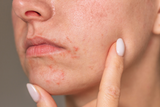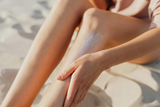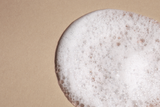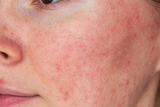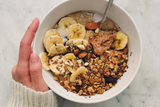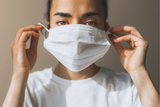Easy Peasy You
Squeeze pimples: With these 7 steps you will get used to pinching
Posted by Lara Schimweg on
In order to break the habit of popping pimples, you sometimes have to distract yourself
Have you ever wondered: Is it good to squeeze pimples or should I leave them alone? And if it's good: how do I squeeze pimples correctly?
You stand in front of your mirror and think: Just press it once and the thing will be gone and your skin will look smooth again. A pimple like this literally invites us to do it with its yellow, protruding head. And I could quickly express the little black one next to it.
The closer you put your head to the mirror, the more small imperfections you will find. Before you know it, you've already started, squeezing and pinching everywhere. It's just a shame that your face is anything but clean afterwards.
The pimple is gone after you squeeze it, but the skin in the area is now red and swollen. You can still see prints of your fingernails. Maybe you're annoyed about it. You hope that the prints disappear quickly. And after a few hours, your skin is actually less red and swollen and the nail marks have faded a bit. Hopefully there won't be tomorrow...
But the next morning: In the place where there was only a small blackhead before - now there is a thick inflammation that hurts. As you already knew.
Sometimes it looks like you've scratched all over your face. Small red dots, crusts and cracks. Several thick inflammations have formed in the same places. And yes, there are new pimples right next to them. There wasn't anything there yesterday, right?
Do you know such situations? Are you angry with yourself then? Then our 7 tips will help you break the habit of picking and popping pimples. But first, let's clarify how pimples form and why we like to pick on them.
The sebaceous glands are located at the hair roots in your skin . These produce fat. This fat, also called sebum , is like your own cream for your skin. So it's good to have a little oil on your skin. It protects your skin and ensures that you don't lose too much moisture. The sebaceous glands produce more fat, especially during puberty. If dead skin cells clog your pore, the sebum can no longer drain away easily. There is a traffic jam and an elevation is created. A closed pimple. Please do not press on it, otherwise the pimple can quickly become infected. If your pimple has a small black cap, it is an open pimple. You probably also know them by the name blackheads . The black cap is just the sebum that has come into contact with oxygen. The sebum oxidizes and turns black. If you press the pimple with your fingers, you would introduce bacteria into the pimple. And so a small pimple can become infected very quickly. It swells, becomes red and larger. And such a real inflammation not only hurts, it also takes longer for it to disappear again.
The wrong skin care routine can also throw your skin out of balance. If you use too many unnecessary products, it is pure stress for your skin . Irritating substances and drying alcohols can also cause pimples because your skin produces too much oil after such stimuli. And too many active ingredients can overwhelm sensitive skin.
With mild, minimalist skin care, your sebum can drain away much more easily and there will be significantly less inflammation and fewer pimples in your skin.
So what can you do if you have a pimple and want to pop it? Sure, you can suppress it all the time. However, this is exhausting and usually difficult to maintain. So here are 7 steps that can help you if you ever feel the need to pop a pimple.
After a while you may no longer need a piece of paper. Wouldn't that be nice?
If you live with other people who you don't want to notice, you can simply use a sticker - for example with a smiley face.
Maybe you miss the pressure at the beginning. That's completely okay. You shouldn't be ashamed of that. Consciously be happy that you are currently managing to pick at your pimples less or even not at all. The best thing to do is say that to yourself directly in the mirror. Nobody has to notice if it makes you uncomfortable.
It's completely understandable if you don't find it so easy at the beginning. It takes a while to learn your new habit. At some point you won't even think about popping pimples anymore.
If it ever gets to that point and your message to yourself isn't strong enough: leave the mirror and do something else straight away.
Whenever you feel like popping pimples, put another habit in that spot. Do something good for yourself: do some exercise, drink a cup of tea, pick up your favorite book or write to a friend about how you're feeling.
In the best case scenario, you replace the old habit with a new one. It could look like this: You see a wonderful, ripe pimple that you would like to pop. Walk right away from the mirror, make yourself your favorite tea. Whenever it comes over you, you can now be sure that the tea is waiting for you and will keep you from pushing.
You will see: it works. And after a cup of tea, you no longer feel like popping the pimple.
And that's the crux of the matter: With this mirror you can see every pore, every pimple and every blackhead as huge. In reality, everything is much smaller and you wouldn't even notice it in everyday life. And other people don't even notice it.
If you don't believe that, why not ask your friends where you have pimples? They will probably count for a lot less than you.
So either throw away the magnifying mirror or only use it when you're actually using it for makeup. If you want to keep the mirror, put a cute sticker on it too. This will always remind you that you only want to use it for your makeup. Not to look at your skin in meticulous and overcritical detail.
If you happen to have really inflamed, closed pimples, you shouldn't squeeze them either. You can provide them with targeted care so that they open or heal more quickly.
You can apply skin care with zinc selectively to your skin. This will reduce the inflammation over the course of a few days. If you do this regularly you will have less inflammation in your skin.
A minimalist skin care routine can go a long way toward reducing inflammation in your skin. If that's not enough, you can gently exfoliate your skin. With a Enzyme peeling You remove the uppermost skin cells and help the skin so that the sebum can flow out of the pores better. It is enough if you use the peeling 1-2 times a week.
If you want to make more, you can also use salicylic acid. You can use these selectively but also over large areas. It ensures that your skin is exfoliated and the sebum in the pore is dissolved. Please remember that salicylic acid can be a strong irritant to your skin . Start gently and see how your skin reacts. And please don't forget sun protection if you want to use these active ingredients.
Remember: Don't take a picture like your old magnifying mirror would. Take a normal photo of yourself, the way other people see you every day. Because that is much more realistic.
This will help you notice that your new habits are showing results. Whenever you look at the old pictures, you will feel how powerful your actions are. This will make you strong and self-confident and encourage you in your new behaviors.
Has the “don’t push” message become second nature? Do you know your skin, know how it feels and can you assess your pimples well? And do you also handle active ingredients carefully?
Then it's time for you to pop a pimple again.
Jump for joy? - No, you don't need it. You now have your cup of tea or something else that makes you happy now.
Always view expressing yourself as a last resort. And only if the following conditions are met:
Here's the best way to proceed: Wash your hands thoroughly. Take a clean washcloth or cloth and soak it in lukewarm water. Place the warm cloth lightly on your skin and warm the area around the pimple. This stimulates blood circulation and makes it easier to remove sebum. It is possible that the slight heat will cause the pimple to drain away on its own. That would of course be wonderful. If that's not the case: divide a tissue and wrap the halves around the fingertips of your two index fingers so that you don't cause nail marks in your skin when you press. Now gently press once from above and below and then from the right and left of the pimple to push the sebum outwards. Don't press too hard. If the sebum doesn't come out with light pressure and you feel like you should press harder, the pimple isn't ready yet. Then don't press any further, otherwise you would push the sebum inwards. This would result in deeper inflammation and possibly new pimples.
Once the sebum is out, you can disinfect the small open area with some wound disinfectant. You do not need to disinfect the surrounding skin. That would just dry them out too much.
You notice: You can't just pop a pimple in front of the mirror in the elevator, on the train or on the bus. This requires some preparation and aftercare. This is the only way you can avoid new underlays.
This fun toy simulates popping pimples. A small worm comes out of a rubber skin dummy when you press correctly. And don't worry, no pus or sebum will come out. The mass consists of beeswax and olive oil.
Maybe on days when the urge is too great and all other tips don't work, it will help you to stop squeezing your own face. Who knows, maybe you'll even find squeezing this toy so absurd or disgusting that you won't feel like popping pimples on your face anymore.
Also consider getting help. If you suffer from skin picking, please talk to your doctor about it. You don't have to be ashamed of it. Everyone has annoying habits or other problems. And in the end, all that matters is that you feel better and that you can develop a suitable solution for yourself so that you feel comfortable in your own skin again.
If pimples don't go away as quickly as you'd like. And if skin care products don't work as quickly, then it's not the end of the world. It's annoying and annoying. However, realize that it will only be like this for a limited time.
You can continue to target your pimples, cover them, or own them and give your skin the time it needs to heal.
Of course, it's not easy to accept pimples, but you can learn: Just like the new behavior of not picking pimples, this is also a process. Which takes a while.
You might just get a pimple. Women sometimes suffer more, sometimes less, when they start menstruating. Pimples can also occur more often during periods of stress or when you don't have a great diet. It may be that your skin is very sensitive and reacts with some inflammation. You may also have a skin condition that comes in flare-ups, such as rosacea. If you have more pimples and pustules, don't beat yourself up.
Life is not a straight line. It's a constant up and down. Pimples also go away. Sometimes it goes faster and sometimes it takes a little longer.
Don't let yourself get stressed. Instead, be happy about the small successes and tell yourself often how beautiful and good you think you are. That's you! Whether with or without inflammation on the face!
Just tell yourself what you like about yourself in your reflection every day. This will make you strong. This is not only good for your skin but also for your psyche.
Enjoy your skin care and see it as a good thing. This is time for you that you take.
Stop saying that you take care of your skin because you want to get rid of inflammation and pimples. Sounds much better: I know what is good for me and my skin. And I'm happy that I've learned to deal with it. Or what do you mean?
So let's go into your new positive life. With a good attitude towards yourself.
You can do that! You are on the right way.
One healthy minimalist skin care can support you Most of it will come from you though.
Have you ever wondered: Is it good to squeeze pimples or should I leave them alone? And if it's good: how do I squeeze pimples correctly?
You stand in front of your mirror and think: Just press it once and the thing will be gone and your skin will look smooth again. A pimple like this literally invites us to do it with its yellow, protruding head. And I could quickly express the little black one next to it.
The closer you put your head to the mirror, the more small imperfections you will find. Before you know it, you've already started, squeezing and pinching everywhere. It's just a shame that your face is anything but clean afterwards.
The pimple is gone after you squeeze it, but the skin in the area is now red and swollen. You can still see prints of your fingernails. Maybe you're annoyed about it. You hope that the prints disappear quickly. And after a few hours, your skin is actually less red and swollen and the nail marks have faded a bit. Hopefully there won't be tomorrow...
But the next morning: In the place where there was only a small blackhead before - now there is a thick inflammation that hurts. As you already knew.
Sometimes it looks like you've scratched all over your face. Small red dots, crusts and cracks. Several thick inflammations have formed in the same places. And yes, there are new pimples right next to them. There wasn't anything there yesterday, right?
Do you know such situations? Are you angry with yourself then? Then our 7 tips will help you break the habit of picking and popping pimples. But first, let's clarify how pimples form and why we like to pick on them.
How do pimples form?
There is a short explanation in this 3 minute video in a funny comic style:The sebaceous glands are located at the hair roots in your skin . These produce fat. This fat, also called sebum , is like your own cream for your skin. So it's good to have a little oil on your skin. It protects your skin and ensures that you don't lose too much moisture. The sebaceous glands produce more fat, especially during puberty. If dead skin cells clog your pore, the sebum can no longer drain away easily. There is a traffic jam and an elevation is created. A closed pimple. Please do not press on it, otherwise the pimple can quickly become infected. If your pimple has a small black cap, it is an open pimple. You probably also know them by the name blackheads . The black cap is just the sebum that has come into contact with oxygen. The sebum oxidizes and turns black. If you press the pimple with your fingers, you would introduce bacteria into the pimple. And so a small pimple can become infected very quickly. It swells, becomes red and larger. And such a real inflammation not only hurts, it also takes longer for it to disappear again.
The wrong skin care routine can also throw your skin out of balance. If you use too many unnecessary products, it is pure stress for your skin . Irritating substances and drying alcohols can also cause pimples because your skin produces too much oil after such stimuli. And too many active ingredients can overwhelm sensitive skin.
With mild, minimalist skin care, your sebum can drain away much more easily and there will be significantly less inflammation and fewer pimples in your skin.
Why do we actually like squeezing pimples?
Even our ancestors, the monkeys, attached great importance to good grooming. As humans, we quickly develop habits - especially when they are paired with success. That's why it can be so hard to just let a pimple be and not press on it. Because it satisfies us when we can squeeze a sebaceous worm out of our skin.So what can you do if you have a pimple and want to pop it? Sure, you can suppress it all the time. However, this is exhausting and usually difficult to maintain. So here are 7 steps that can help you if you ever feel the need to pop a pimple.
With these 7 steps you can get used to popping pimples
Step 1: The note on the mirror
Write yourself the simple message “Don’t pop pimples. It’s not worth it!” on a piece of paper. Stick this on the mirrors that you like to look into and where you get ready. From now on, whenever you look into this mirror, you will read your message to yourself.After a while you may no longer need a piece of paper. Wouldn't that be nice?
If you live with other people who you don't want to notice, you can simply use a sticker - for example with a smiley face.
Step 2: Reinforce your message to yourself
Tell a friend you trust about this technique. Tell her or him how much it brings you. Tell your boyfriend or girlfriend what this does to you emotionally. Talk about how it feels that you're no longer popping the pimples. This means you are not completely alone in your efforts. This will reinforce your own belief in sticking with your new habit.Maybe you miss the pressure at the beginning. That's completely okay. You shouldn't be ashamed of that. Consciously be happy that you are currently managing to pick at your pimples less or even not at all. The best thing to do is say that to yourself directly in the mirror. Nobody has to notice if it makes you uncomfortable.
It's completely understandable if you don't find it so easy at the beginning. It takes a while to learn your new habit. At some point you won't even think about popping pimples anymore.
Step 3: Distract yourself when you want to pop pimples
Do you know that? Sometimes a pimple is just too pretty. You can already imagine how satisfying it will be to just express it. The feeling when the sebum bursts out of the pore.If it ever gets to that point and your message to yourself isn't strong enough: leave the mirror and do something else straight away.
Whenever you feel like popping pimples, put another habit in that spot. Do something good for yourself: do some exercise, drink a cup of tea, pick up your favorite book or write to a friend about how you're feeling.
In the best case scenario, you replace the old habit with a new one. It could look like this: You see a wonderful, ripe pimple that you would like to pop. Walk right away from the mirror, make yourself your favorite tea. Whenever it comes over you, you can now be sure that the tea is waiting for you and will keep you from pushing.
You will see: it works. And after a cup of tea, you no longer feel like popping the pimple.
Step 4: Throw away the magnifying mirror
Honestly, why do we need magnifying mirrors? It is useful if you want to do dramatic eye make-up. Otherwise it's not very helpful. No one you come into contact with in everyday life comes as close to your skin as your magnifying mirror.And that's the crux of the matter: With this mirror you can see every pore, every pimple and every blackhead as huge. In reality, everything is much smaller and you wouldn't even notice it in everyday life. And other people don't even notice it.
If you don't believe that, why not ask your friends where you have pimples? They will probably count for a lot less than you.
So either throw away the magnifying mirror or only use it when you're actually using it for makeup. If you want to keep the mirror, put a cute sticker on it too. This will always remind you that you only want to use it for your makeup. Not to look at your skin in meticulous and overcritical detail.
Step 5: Treat pimples correctly
Nobody wants to use these methods to get rid of your pimples, which may be red, inflamed and swollen. It was in the upper points, around the small pores that carry a little more sebum.If you happen to have really inflamed, closed pimples, you shouldn't squeeze them either. You can provide them with targeted care so that they open or heal more quickly.
You can apply skin care with zinc selectively to your skin. This will reduce the inflammation over the course of a few days. If you do this regularly you will have less inflammation in your skin.
A minimalist skin care routine can go a long way toward reducing inflammation in your skin. If that's not enough, you can gently exfoliate your skin. With a Enzyme peeling You remove the uppermost skin cells and help the skin so that the sebum can flow out of the pores better. It is enough if you use the peeling 1-2 times a week.
If you want to make more, you can also use salicylic acid. You can use these selectively but also over large areas. It ensures that your skin is exfoliated and the sebum in the pore is dissolved. Please remember that salicylic acid can be a strong irritant to your skin . Start gently and see how your skin reacts. And please don't forget sun protection if you want to use these active ingredients.
Step 6: Record your progress privately in photos
It's important that you learn to assess inflammation. Photos can help you initially. Document the progress of your healing for yourself.Remember: Don't take a picture like your old magnifying mirror would. Take a normal photo of yourself, the way other people see you every day. Because that is much more realistic.
This will help you notice that your new habits are showing results. Whenever you look at the old pictures, you will feel how powerful your actions are. This will make you strong and self-confident and encourage you in your new behaviors.
Step 7: Remove ripe pimples using the right method
Has the “don’t push” message become second nature? Do you know your skin, know how it feels and can you assess your pimples well? And do you also handle active ingredients carefully?
Then it's time for you to pop a pimple again.
Jump for joy? - No, you don't need it. You now have your cup of tea or something else that makes you happy now.
Always view expressing yourself as a last resort. And only if the following conditions are met:
- Your pimple is ripe
- He is open
- A clear yellow plug can be seen
- The pimple is tight
- It feels like the pimple is about to empty
Here's the best way to proceed: Wash your hands thoroughly. Take a clean washcloth or cloth and soak it in lukewarm water. Place the warm cloth lightly on your skin and warm the area around the pimple. This stimulates blood circulation and makes it easier to remove sebum. It is possible that the slight heat will cause the pimple to drain away on its own. That would of course be wonderful. If that's not the case: divide a tissue and wrap the halves around the fingertips of your two index fingers so that you don't cause nail marks in your skin when you press. Now gently press once from above and below and then from the right and left of the pimple to push the sebum outwards. Don't press too hard. If the sebum doesn't come out with light pressure and you feel like you should press harder, the pimple isn't ready yet. Then don't press any further, otherwise you would push the sebum inwards. This would result in deeper inflammation and possibly new pimples.
Once the sebum is out, you can disinfect the small open area with some wound disinfectant. You do not need to disinfect the surrounding skin. That would just dry them out too much.
You notice: You can't just pop a pimple in front of the mirror in the elevator, on the train or on the bus. This requires some preparation and aftercare. This is the only way you can avoid new underlays.
Bonus tip:
If you miss the satisfaction of popping a pimple some days when the sebaceous worm curls out of your pore. The feeling: yes, now I'm about to empty you. Then we have a somewhat unconventional tip for those really bad days: The Pimple Picker .This fun toy simulates popping pimples. A small worm comes out of a rubber skin dummy when you press correctly. And don't worry, no pus or sebum will come out. The mass consists of beeswax and olive oil.
Maybe on days when the urge is too great and all other tips don't work, it will help you to stop squeezing your own face. Who knows, maybe you'll even find squeezing this toy so absurd or disgusting that you won't feel like popping pimples on your face anymore.
If you can't squeeze out pimples anymore: What is skin picking?
By the way, squeezing pimples and constantly picking and scratching the skin can become a real addiction. Skin picking is a real condition. Those affected cannot resist squeezing pimples. Even when the skin heals again, they pick off the crusts again. This means the skin hardly has a chance to regenerate. People who suffer from skin picking often not only feel uncomfortable with their addiction, they also suffer from constantly injured skin. Because the wounds can cause scars. Such injuries to the skin lead to pain. Such an illness can also be very stressful psychologically. Do you know that about yourself? Jaqueline writes in her blog about her life with skin picking . Maybe it will help you to take a look at her blog.Also consider getting help. If you suffer from skin picking, please talk to your doctor about it. You don't have to be ashamed of it. Everyone has annoying habits or other problems. And in the end, all that matters is that you feel better and that you can develop a suitable solution for yourself so that you feel comfortable in your own skin again.
Why you should just accept pimples in certain phases of life
If pimples don't go away as quickly as you'd like. And if skin care products don't work as quickly, then it's not the end of the world. It's annoying and annoying. However, realize that it will only be like this for a limited time.
You can continue to target your pimples, cover them, or own them and give your skin the time it needs to heal.
Of course, it's not easy to accept pimples, but you can learn: Just like the new behavior of not picking pimples, this is also a process. Which takes a while.
You might just get a pimple. Women sometimes suffer more, sometimes less, when they start menstruating. Pimples can also occur more often during periods of stress or when you don't have a great diet. It may be that your skin is very sensitive and reacts with some inflammation. You may also have a skin condition that comes in flare-ups, such as rosacea. If you have more pimples and pustules, don't beat yourself up.
Life is not a straight line. It's a constant up and down. Pimples also go away. Sometimes it goes faster and sometimes it takes a little longer.
Don't let yourself get stressed. Instead, be happy about the small successes and tell yourself often how beautiful and good you think you are. That's you! Whether with or without inflammation on the face!
Just tell yourself what you like about yourself in your reflection every day. This will make you strong. This is not only good for your skin but also for your psyche.
Enjoy your skin care and see it as a good thing. This is time for you that you take.
Stop saying that you take care of your skin because you want to get rid of inflammation and pimples. Sounds much better: I know what is good for me and my skin. And I'm happy that I've learned to deal with it. Or what do you mean?
In the future it might look like this for you:
My evening skin care routine is no longer a must. I'm more happy that I know what I can do and enjoy the time and appreciation that I can finally give myself. Some days I'm greeted by one or two small pimples. But that's okay. Because I am more than just my pimples. And if you ever really long to squeeze out pimples, you can Videos from Dr. Watch Pimple Popper . But be careful: the pimples that are expressed and treated here are real cases for medicine. It's good to know that it's not so bad that you have a small pimple every now and then that luckily disappears on its own.So let's go into your new positive life. With a good attitude towards yourself.
You can do that! You are on the right way.
One healthy minimalist skin care can support you Most of it will come from you though.
How do you deal with pimples?
Do you also find it difficult not to press? Tell us and write us your faces and your feelings in the comments?- Tags: Akne, Hautkrankheiten, Hautpflege, Pickel
← Older Post Newer Post →
0 comments


